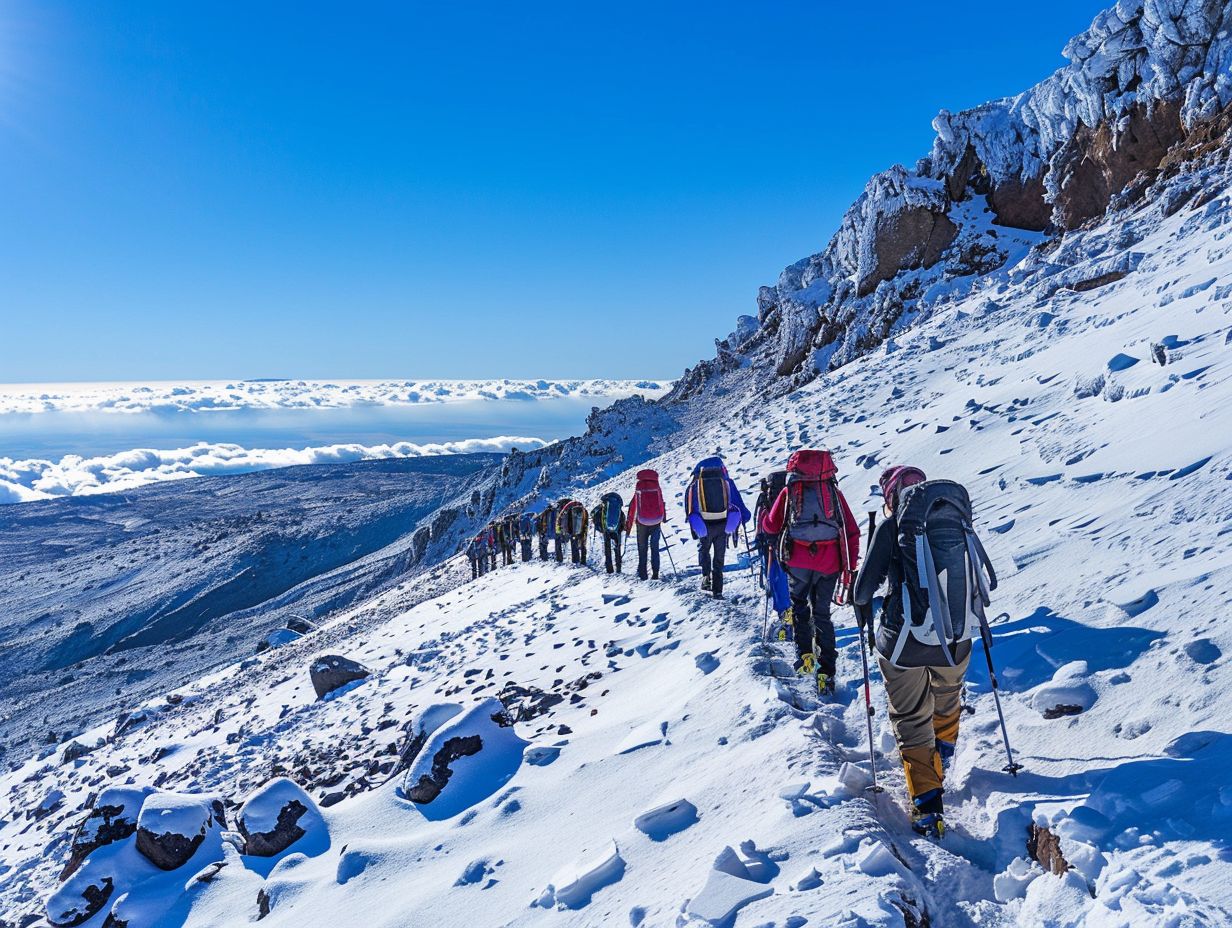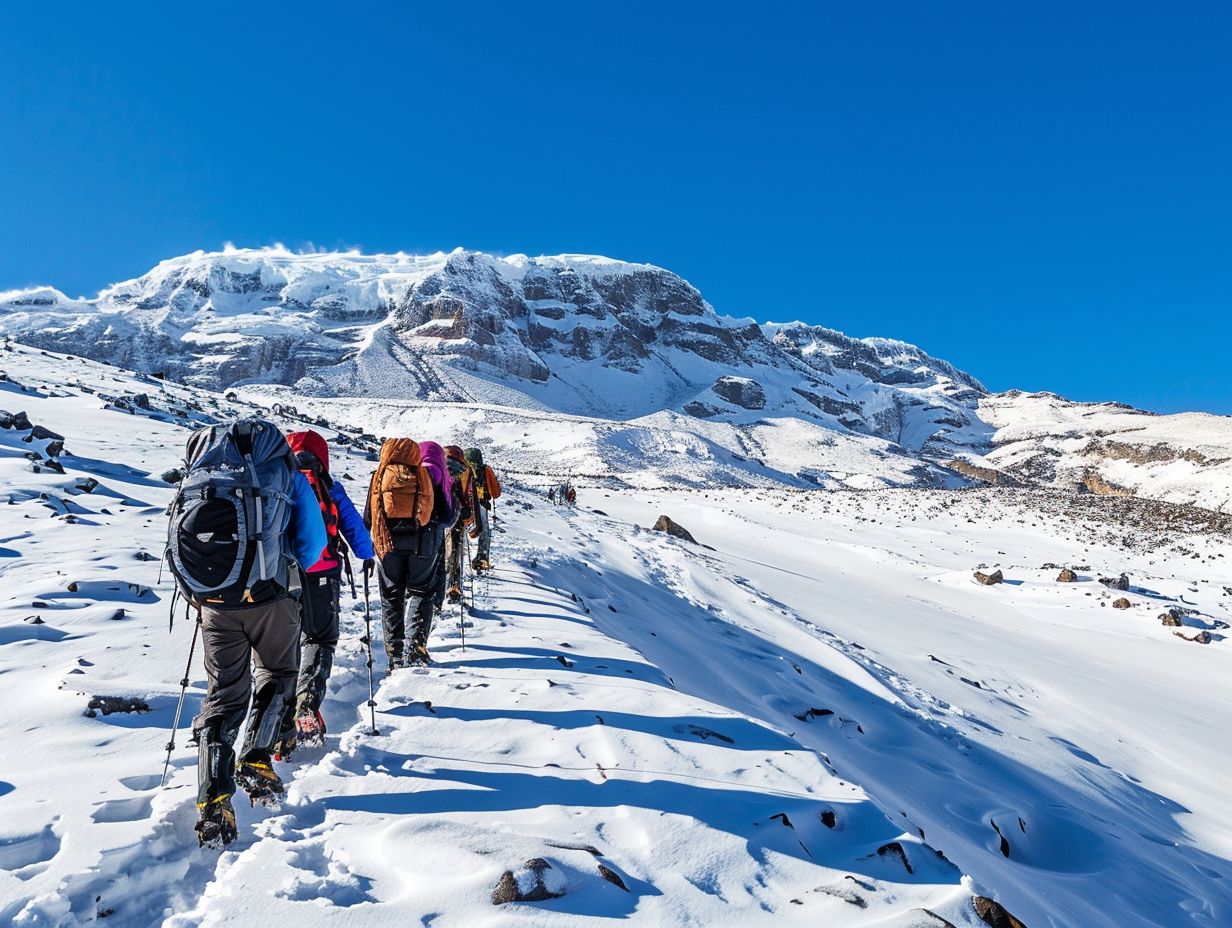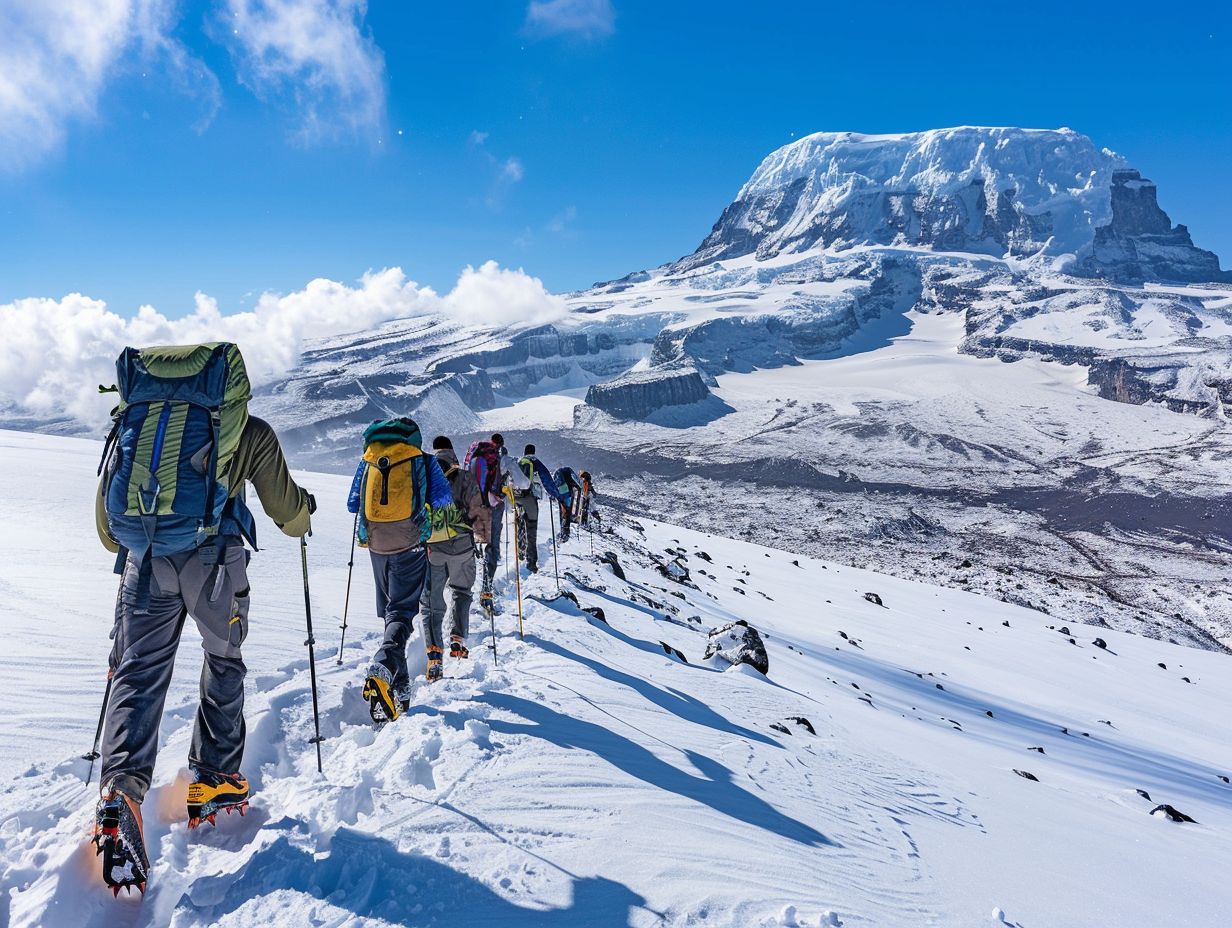
Climbing Kilimanjaro In July
Considering embarking on the adventure of a lifetime by climbing Kilimanjaro in July?
In this comprehensive guide, we will explore the reasons why July is an ideal time to conquer Africa’s tallest peak.
From favorable weather conditions to fewer crowds and high success rates, we will discuss everything you need to know before planning your Kilimanjaro expedition.
We will cover the different routes, physical demands, safety precautions, costs, accommodation options, best itinerary, and essential packing tips for your July climb.
Let’s get started!
Key Takeaways:

- Climbing Kilimanjaro in July offers optimal weather conditions, fewer crowds, and a high success rate.
- The different routes to climb Kilimanjaro include Marangu, Machame, Lemosho, Rongai, and Northern Circuit.
- Climbing Kilimanjaro requires physical demands such as altitude sickness, stamina and endurance, and proper gear and equipment.
Why Climb Kilimanjaro in July?
July is one of the best months to climb Kilimanjaro due to the favorable weather conditions, including clear skies, minimal precipitation, and comfortable temperatures.
1. Weather Conditions
The weather conditions on Kilimanjaro vary throughout the year, with July being part of the dry season, offering climbers clear skies, lower precipitation levels, and warmer temperatures.
During the dry season from June to October, Kilimanjaro experiences less rainfall and more stable weather patterns, making it the preferred time for climbing.
In contrast, the wet season from March to May brings heavy rains, potentially causing slippery conditions and reduced visibility.
Climbers who choose to summit during the dry season typically enjoy breathtaking views of the surrounding landscapes.
2. Fewer Crowds
In July, Kilimanjaro experiences fewer crowds as compared to peak tourist months, allowing climbers to enjoy a more serene and intimate experience while ascending the mountain, appreciating the tranquility of the surroundings.
Less crowded trails mean more space to appreciate the diverse flora and fauna along the way, fostering a deeper connection with nature.
The peaceful ambiance also enhances the overall climbing experience, allowing climbers to focus on their personal journey and immerse themselves fully in the beauty of Kilimanjaro.
3. High Success Rate
During July, climbers are met with milder temperatures compared to other months, reducing the risk of extreme cold or heat exhaustion.
The drier weather minimizes the chances of encountering heavy rainfall, making the ascent smoother and safer.
The clear skies in July offer unparalleled visibility of the surrounding landscape, adding to the allure of the climb.
These factors collectively contribute to the increased success rates during this month, attracting many enthusiasts seeking to conquer Africa’s highest peak.
What are the Different Routes to Climb Kilimanjaro?
When embarking on the journey to conquer Kilimanjaro, climbers have various routes to choose from, such as the popular Lemosho Route and the scenic Rongai Route, each offering unique challenges and breathtaking vistas along the way.
1. Marangu Route

The Marangu Route, also known as the ‘Coca-Cola’ route offers comfortable sleeping huts and a gradual ascent, making it suitable for climbers seeking a less strenuous journey.
What sets the Marangu Route apart is its well-established infrastructure, with bunk beds and communal dining areas provided in the huts along the way.
Unlike some other routes where camping is the norm, Marangu offers a more ‘hotel-like’ experience.
This has led to its nickname as the ‘Coca-Cola’ route, signifying the relative luxury it provides compared to the more rugged paths.
The gradual ascent of Marangu, although not as scenic as some other routes, reduces the risk of altitude sickness for many climbers.
2. Machame Route
The Machame Route, known for its scenic beauty and varied terrain offers stunning views and a more demanding ascent compared to other routes.
Located in Tanzania, the Machame Route starts from the southwestern side of Mount Kilimanjaro and is famous for its diverse landscapes.
Hikers experience lush rainforests at lower altitudes, before ascending to rocky terrain and alpine deserts.
This route provides adventurers with a true taste of the mountain’s beauty, as they navigate through different ecological zones.
The mountain views along the way are breathtaking, with moments of awe-inspiring beauty that serve as a constant reward for the physical exertion required.
3. Lemosho Route
The Lemosho Route is favored for its scenic vistas, diverse ecosystems, and the option to acclimatize at the picturesque Kosovo Camp.
One of the key characteristics of the Lemosho Route is its gradual ascent, which allows climbers to acclimatize effectively and reduce the risk of altitude sickness.
The route takes you through varied landscapes, from lush rainforests to alpine deserts, providing a truly immersive experience in the beauty of Kilimanjaro.
Kosovo Camp serves as a crucial stopping point for acclimatization, situated at a strategic altitude to help climbers adapt to the changing conditions.
As climbers rest at Kosovo Camp, they can enjoy stunning views of the surrounding scenery, preparing themselves for the challenges ahead.
4. Rongai Route
The Rongai Route offers a more secluded and less crowded path to the summit, providing a sense of tranquility and unique perspectives on the mountain’s beauty.
The lush forest landscapes on the lower slopes gradually give way to expansive views of the Kenyan plains, creating an awe-inspiring backdrop to the trek.
Steeped in quietude, this path allows trekkers to immerse themselves in nature, away from the hustle and bustle of other routes.
The serenity along the Rongai Route brings a sense of peace and introspection, enhancing the overall experience of climbing Kilimanjaro.
5. Northern Circuit Route
The Northern Circuit Route offers climbers an adventurous and immersive journey through diverse landscapes, remote areas, and stunning panoramas that showcase the mountain’s grandeur.
Unlike the more popular routes like Marangu and Machame, the Northern Circuit Route spans around 9 to 10 days, providing a slower pace.
It’s remoteness sets it apart from other paths, allowing trekkers to enjoy a sense of solitude and tranquility amidst nature’s untouched beauty.
The trail takes climbers through various climate zones, from lush rainforests to alpine deserts, offering a unique experience.
The route’s unparalleled panoramic views of Kilimanjaro’s northern slopes and distant plains create a visual spectacle.
What are the Physical Demands of Climbing Kilimanjaro?
Climbing Kilimanjaro requires physical preparedness to combat challenges such as altitude sickness, the need for exceptional stamina and endurance, and the importance of having the right climbing gear and equipment for a safe and successful ascent.
1. Altitude Sickness
Altitude sickness can have varying effects on individuals, making it crucial to acclimatize properly and recognize the symptoms to ensure a safe climb.
When climbing Kilimanjaro, the body undergoes significant changes as it adjusts to the decreasing oxygen levels at higher altitudes.
Symptoms of altitude sickness can hinder a climber’s progress and even lead to more severe conditions if not addressed promptly.
Acclimatization, the process of allowing the body to adapt to the reduced oxygen levels, is essential for a successful ascent.
Climbers are advised to pace themselves, hydrate adequately, and listen to their bodies for any signs of distress.
2. Stamina and Endurance

Stamina and endurance are crucial for Kilimanjaro climbers, demanding physical fitness and mental resilience to sustain the challenging trek, long hours of walking, and diverse terrains encountered during the ascent.
The journey to the summit involves crossing multiple climate zones, from tropical forests to alpine deserts, challenging not only the body but also the mind.
Maintaining a steady pace, staying hydrated, and acclimatizing to the altitude are crucial elements of success.
Climbers must be prepared for drastic weather changes, extreme temperatures, and the effects of high altitude, which can include altitude sickness, fatigue, and shortness of breath.
Mental fortitude plays a decisive role in overcoming these obstacles, pushing climbers beyond their perceived limits.
3. Climbing Gear and Equipment
The right climbing gear and equipment are crucial, encompassing items like trekking poles, thermal clothing, sturdy boots, and high-altitude gear.
Having the proper climbing gear not only enhances the overall experience but also plays a vital role in the safety and success of the ascent.
Plus the essentials mentioned earlier, climbers should also consider carrying a reliable backpack, headlamp, gloves, and sunglasses to combat the varying weather.
A good quality sleeping bag rated for low temperatures is imperative for the cold nights at higher altitudes.
Packing necessary nutrition like energy bars, electrolyte tablets, and hydration bladder is essential to maintain energy levels and hydration throughout the climb.
What are the Safety Precautions for Climbing Kilimanjaro?
Ensuring safety while climbing Kilimanjaro involves taking necessary precautions such as proper acclimatization to altitude, relying on experienced guides and porters for assistance, and dedicating time for training and preparation to mitigate risks and enhance the climbing experience.
1. Acclimatization
Acclimatization helps minimize the risk of altitude sickness and ensures a safer and more enjoyable trek to the summit.
Acclimatization involves allowing the body to adapt to higher elevations by giving it time to produce more red blood cells and increase oxygen intake.
This process is crucial in preventing severe conditions like HAPE (High Altitude Pulmonary Edema) and HACE (High Altitude Cerebral Edema), which can be life-threatening.
By ascending slowly and giving the body time to adjust, climbers can significantly reduce the chances of experiencing these altitude-related illnesses.
Proper acclimatization also improves physical performance, making the climb more manageable.
2. Experienced Guides and Porters
Relying on experienced guides and porters is crucial for navigation, support, and safety, as their expertise and assistance can enhance the overall climbing.
Expert guides play a pivotal role in leading climbers through the diverse terrains and challenging routes of Kilimanjaro.
Their in-depth knowledge of the mountain helps in avoiding potential hazards and selecting the best paths to summit successfully.
The importance of porters cannot be overstated, carrying essential gear and supplies, lightening the load for climbers.
These experienced professionals ensure safety and offer valuable insights into the local culture and environment, enriching the journey with their stories and expertise.
Their support fosters a sense of camaraderie among climbers, making the expedition not just a physical challenge but also a memorable experience.
3. Proper Training and Preparation
Proper training and preparation are essential , encompassing physical conditioning, altitude simulation, and familiarization with gear and terrain to ensure readiness, safety, and confidence during the ascent.
Physical conditioning plays a crucial role in preparing , as it demands endurance and strength to conquer the varying terrains and altitudes.
Altitude simulation helps acclimatize the body to reduced oxygen levels, reducing the risk of altitude sickness.
Familiarity with gear is vital for a successful climb, ensuring climbers are equipped for diverse weather conditions and unexpected situations.
What is the Cost of Climbing Kilimanjaro in July?
The cost of climbing Kilimanjaro in July varies based on factors such as chosen route, duration of the expedition, accommodation preferences, and included services, with prices typically ranging from modest to upscale options to cater to different budgets and comfort levels.
One of the significant cost considerations when planning a Kilimanjaro climb in July is the route selection.
- Popular routes like the Marangu and Machame tend to be more affordable due to their accessibility and infrastructure.
- On the other hand, routes like Lemosho or Northern Circuit, offering more solitude and scenic views, often come at a higher price point.
Longer expeditions, such as those including acclimatization days, can incur higher expenses compared to shorter, more direct ascents.
Accommodation preferences also influence the cost of climbing Kilimanjaro.
- Opting for standard shared tents or upgrading to private tents or even luxury lodges on certain routes can significantly affect the total expenses.
- Those looking for more comfort and amenities during the expedition should be prepared for higher costs.
Another cost variable is the level of services included in the package.
- Basic packages may cover essential services like guide, porters, meals, and park fees, while premium packages may offer additional services such as personal porters, specialized cuisine, or exclusive amenities.
- The range of services included directly impacts the overall cost of the climb.
What are the Accommodation Options for Climbing Kilimanjaro?

For climbers, accommodation options range from basic mountain tents and camping setups to comfortable lodges and luxury campsites.
Basic mountain tents and camping sites offer a true wilderness experience, allowing adventurers to immerse themselves fully in the rugged beauty.
These options often come with shared facilities, communal dining areas, and the simplicity of sleeping under the stars with the mountain as your backdrop.
Upscale lodges and luxury campsites offer heightened comfort and service, featuring amenities like plush bedding, en-suite bathrooms, gourmet dining, and stunning mountain views.
These accommodation choices cater to those seeking a more refined and pampered stay while still being in close proximity to the natural wonders of Kilimanjaro.
What is the Best Itinerary for Climbing Kilimanjaro in July?
Crafting the optimal itinerary involves strategic planning, acclimatization schedules, and route selection tailored to the month’s weather conditions.
July is a popular month for climbing Kilimanjaro due to the relatively dry and clear weather conditions, providing excellent visibility and breathtaking views along the way.
When planning your itinerary, it’s crucial to consider the gradual acclimatization process to prevent altitude sickness and enhance your overall climbing experience.
Customizing your route based on July’s weather patterns can help optimize your chances of a successful summit bid.
Routes like the Lemosho and Machame offer diverse landscapes and adequate time for acclimatization, increasing your chances of reaching the summit.
Incorporating rest days into your itinerary allows for recovery and adjustment to the altitude, ensuring a safer and more enjoyable climb.
Being prepared for temperature variations by packing suitable gear and staying well-hydrated are vital considerations for a successful July climb on Kilimanjaro.
What Should You Pack for Climbing Kilimanjaro in July?
Packing essentials for climbing Kilimanjaro in July includes items like thermal clothing, sturdy footwear, high-altitude gear, personal medications, and outdoor essentials to ensure comfort, safety, and preparedness.
It is crucial to bring along a reliable backpack that can comfortably carry all your gear without hindering your movement.
Go for a waterproof backpack to protect your essentials from the occasional showers that can surprise you on the mountain.
Staying properly hydrated is vital for combating altitude sickness and maintaining your energy levels.
Don’t forget important personal items such as sunscreen, lip balm with SPF, and sunglasses to shield yourself from the strong UV rays at higher altitudes.
Frequently Asked Questions
1. What is the weather like when climbing Kilimanjaro in July?
A: The weather in July on Mount Kilimanjaro is generally dry and mild, with an average temperature of 10-15 degrees Celsius.
2. Is July a good time to climb Kilimanjaro?
A: Yes, July is considered one of the best months to climb Kilimanjaro. The weather is typically clear and dry, making for optimal climbing conditions.
3. Are there any special considerations for climbing Kilimanjaro in July?
A: Yes, due to the dry season and high altitude, it’s important to stay hydrated and protect yourself from the sun. Be sure to bring plenty of water and sunscreen.
4. What is the success rate for climbing Kilimanjaro in July?
A: The success rate for climbing Kilimanjaro in July is typically around 80%. However, this can vary depending on individual health and fitness levels, as well as weather conditions.
5. What gear should I pack for climbing Kilimanjaro in July?
A: It’s important to pack warm, waterproof and windproof clothing, as well as sturdy hiking boots. You should also bring a good quality sleeping bag and any necessary personal items.
6. Are there any special events or festivals that take place during July on Kilimanjaro?
A: Yes, the Kilimanjaro Marathon takes place in July, which is a popular event for climbers and locals alike. It’s a great way to experience the local culture and support the community.